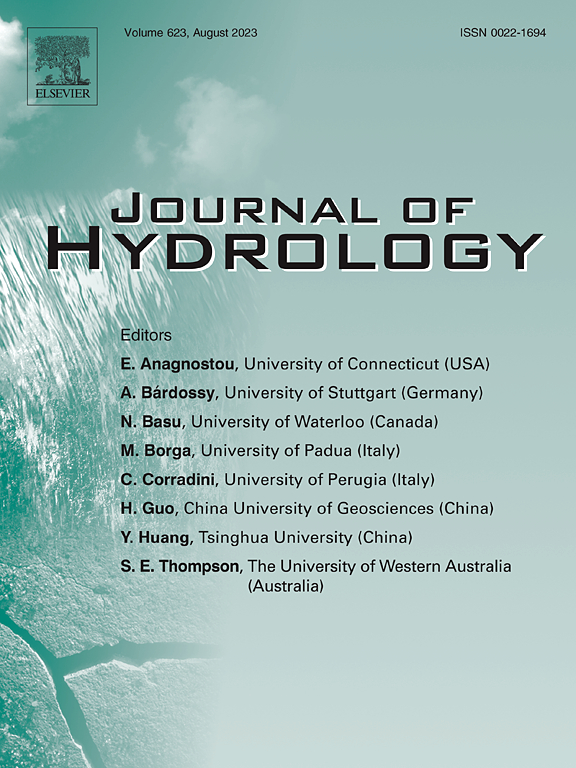亚洲水塔水文动力学的时空异质性
IF 5.9
1区 地球科学
Q1 ENGINEERING, CIVIL
引用次数: 0
摘要
本研究采用高分辨率水文-水动力学模型,对整个亚洲水塔(AWT)地区的水文变化进行了多年(1979-2018)分析。研究发现,整个流域的水文趋势具有显著的时空异质性,其特征是河流流量、蓄水量、洪水状态和陆地蓄水量(TWS)动态的不同变化。西部流域,如阿姆河和塔里木盆地,洪水风险增加(洪水发生率增加~ 60% %),雪水当量(SWE)对TWS的贡献显著(增加~ 41% %),而中部流域正在过渡到水资源日益短缺的地区,恒河的地下蓄水量贡献明显(增加~ 79% %)。地下储存量的优势在东部流域达到顶峰,其中长江和黄河的比例最高(分别为~ 78 %和~ 83 %),长江进一步以显著的河流储存量贡献而区分(~ 21 %)。相比之下,包括湄公河、伊洛瓦底江和萨尔温江在内的东南部盆地呈现出复杂的、随时间变化的模式,无法简单分类。这些发现强调了AWT地表和地下过程的复杂相互作用,强调了在水资源管理和气候变化适应战略中需要针对流域的方法。本文章由计算机程序翻译,如有差异,请以英文原文为准。
Spatio-temporal heterogeneities in hydrologic dynamics across the Asian Water Tower
This study presents a multi-decadal (1979–2018) analysis of hydrologic changes across the entire Asian Water Tower (AWT) region, using high-resolution hydrological-hydrodynamic modeling. We find significant spatiotemporal heterogeneity in hydrological trends across the AWT basins, characterized by diverse changes in river discharge, water storage, flood regimes, and terrestrial water storage (TWS) dynamics. Western basins such as the Amu Darya and Tarim show increasing flood risks (up to ∼60 % increase in flood occurrence) and significant snow water equivalent (SWE) contributions to TWS (up to ∼41 %), while central basins are transitioning to regions of increasing water scarcity with strong subsurface storage contribution evident in the Ganges (up to ∼79 %). The dominance of subsurface storage reaches its peak in the eastern basins, where the Yangtze and Yellow River exhibit the highest proportions (∼78 % and ∼83 % respectively), with the Yangtze further distinguished by a notable river storage contribution (∼21 %). In contrast, southeastern basins including the Mekong, Irrawaddy, and Salween present complex, temporally varying patterns that defy simple categorization. These findings highlight the complex interplay of surface and subsurface processes in the AWT, underscoring the need for basin-specific approaches in water resource management and climate change adaptation strategies.
求助全文
通过发布文献求助,成功后即可免费获取论文全文。
去求助
来源期刊

Journal of Hydrology
地学-地球科学综合
CiteScore
11.00
自引率
12.50%
发文量
1309
审稿时长
7.5 months
期刊介绍:
The Journal of Hydrology publishes original research papers and comprehensive reviews in all the subfields of the hydrological sciences including water based management and policy issues that impact on economics and society. These comprise, but are not limited to the physical, chemical, biogeochemical, stochastic and systems aspects of surface and groundwater hydrology, hydrometeorology and hydrogeology. Relevant topics incorporating the insights and methodologies of disciplines such as climatology, water resource systems, hydraulics, agrohydrology, geomorphology, soil science, instrumentation and remote sensing, civil and environmental engineering are included. Social science perspectives on hydrological problems such as resource and ecological economics, environmental sociology, psychology and behavioural science, management and policy analysis are also invited. Multi-and interdisciplinary analyses of hydrological problems are within scope. The science published in the Journal of Hydrology is relevant to catchment scales rather than exclusively to a local scale or site.
 求助内容:
求助内容: 应助结果提醒方式:
应助结果提醒方式:


